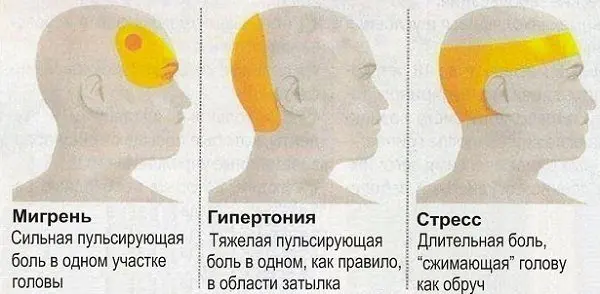😉 Hello dear readers! Migraine: what is it? In this article, you will find basic information on this issue and watch the video.
Migraine: what is it
Migraine is a disease of the nervous system (fr. Migraine), which is accompanied by excruciating headache.
Millions of people all over the world suffer from severe headaches. Statistics indicate that this problem affects approximately 11 percent of the total population on our planet.
This disease interferes with normal activities and is a source of suffering. Even today, many of the secrets of its origin are still not revealed. The most plausible theory is the imbalance of certain substances in the brain.
The attacks of pain are caused by the expansion of the intracranial vessels. To the extent that it irritates certain structures containing a large number of nerve pain receptors.
A study of the brain has shown that during the onset of a headache associated with migraine, the amount of blood flowing in the brain can increase by 300 percent. The factors that contribute to the onset of migraine are obesity, arterial hypertension and hypothyroidism.
Types of migraines
- episodic;
- chronic (recurring attacks every other day or daily);
- menstrual (due to hormonal disruptions);
- ophthalmoplegic (associated with eye diseases).
Migraine symptoms
Unfortunately, the headache itself is not all that this disease has to offer. In the first phase of some types of migraine, you can encounter a whole group of symptoms that occur within a few tens of minutes.

This unpleasant set includes: sensitivity disorders (paresis and hypesthesia, tingling and numbness of hands and feet), visual impairment (decreased vision, flickering, instant blindness, scotoma, zigzags before the eyes).
The next stage of the disease is pain. People suffer from this, complain that they cannot work or rest normally. They are tormented by vomiting and pain, and some relief comes only from being in a dark room, silence and sleep. Although falling asleep when the pain is severe can be difficult.
Migraines are often accompanied by: photophobia (photosensitivity) and phonophobia (increased sensitivity to sound). And there is also an increased sensitivity to odors, nausea, as well as aphasia (speech impairment), which appear in the case of a very intense headache that does not allow concentration.
Other signs:
- dizziness;
- numbness of body parts;
- chills;
- cardiopalmus;
- intense sweating.
The frequency of seizures can vary significantly between people who suffer from the condition. Attacks may occur rarely, or two to three times a month. But one thing is common: the pain is such that it “turns off” a person from real life for several hours.
The most common symptoms are:
- irritability;
- feeling tired;
- increased sensitivity to light;
- nausea, vomiting;
- deterioration of vision;
- severe, shooting pain (more often in the temple area), as a rule, localized in one side, having the character of an attack (one episode of migraine can last from four hours to two days).
How to cure a migraine

The treatment used is often extremely symptomatic. Patients “test” various pain pills or use traditional medicines to try to get rid of unbearable pain.
Unfortunately, there are several types of this disease. Patients experience various ailments that make it impossible to implement any one method of therapy for everyone.
In turn, improper treatment can lead to serious illnesses such as heart attack, heart attack, dependence on pain medications, and chronic migraines.
If you experience very severe pain that appears at regular intervals, you need to consult a doctor to diagnose and find effective methods for eliminating the headache. Oftentimes, people don’t consider that headaches can be a symptom of more serious health problems.
For example, headache, bouts of nausea and vomiting may be the result of food intolerance. Only a qualified neurologist or therapist can help in solving the problem. Therefore, you should not postpone a visit to the clinic and self-medicate.
Today there are 7 groups of drugs for the prevention of this disease, but an experienced specialist is needed to choose a preventive remedy. Unfortunately, there may not be a quick response from treatment. Your patience and time are needed here.
Video
In this video, learn more about Migraine: What It Is.
Friends, share the article “Migraine: what it is: symptoms, treatment” with other people in social. networks. 😉 Always be healthy!










